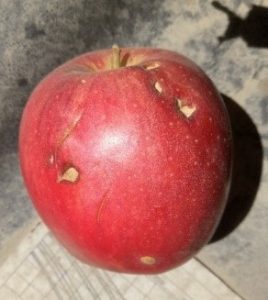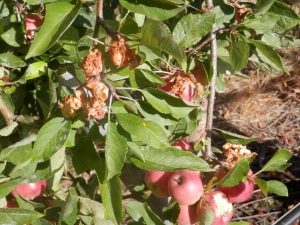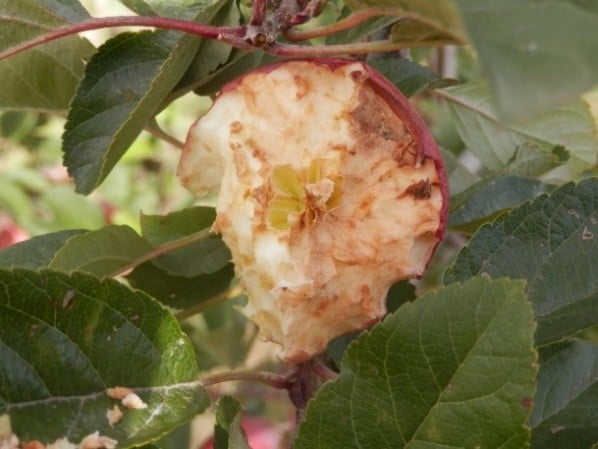Australia’s apple and pear growing areas are located in several diverse regions throughout the country. Each of these regions has its own indigenous (and introduced) species of plants, animals and birds. Most of these species are not a problem for orchardists and can often be beneficial but there are several species that have become pests and cause economic and social problems for orchardists. The pest species vary region by region and the damage caused varies based on what species are causing the damage, the time of year and prevailing environmental conditions.
The following table provides a list of the most significant pest species for pome fruit orchardists around Australia. Individual orchardists may also have localised pest problems not listed.
Table 1. Major regional pest species causing economic and social damage in Australian Pome fruit orchards
| Region | Bird species | Bat species | Animal species |
| Queensland | ***
Rainbow Lorikeets |
Grey Headed Flying Foxes | Kangaroos |
| New South Wales
Bilpin
Orange Batlow |
Rainbow Lorikeets Gang Gang Cockatoo’s Black Cockatoo’s Sulphur Crested Cockatoos Sulphur Crested Cockatoos Crimson Rosella’s |
Little Red Flying Fox
Grey Headed and Little Red Flying Foxes Grey Headed Flying Foxes. |
Wallaby’s
Rabbits & Hares Rabbits & Hares Feral deer Feral Pigs, wombats |
| Victoria
Goulbourn Valley
Yarra Valley |
Sulphur Crested Cockatoos Rainbow & Musk Lorikeets Rainbow & Musk Lorikeets |
Grey Headed Flying Foxes Grey Headed Flying Foxes |
|
| Tasmania | Sulphur Crested Cockatoos
Green Rosellas |
Brushtail Possum
Bennett’s Wallaby++ |
|
| South Australia | Adelaide Hills Rosella
Musk Lorikeet Rainbow Lorikeet |
Grey Headed Flying Fox | Kangaroos
Feral Deer |
| Western Australia | Baudin’s Cockatoos
Carnaby’s Cockatoos |
Kangaroos |
*** The significant area under nets for hail in this region has reduced the damage caused by birds
++ Becoming an increasing problem in young plantings
The damage caused by these species is highly variable and depends on a large number of factors, many linked to environmental conditions such as drought, lack of native tree species flowering, pest species populations and impacts on native habitat. These influences do not necessarily need to be occurring in the actual growing district for there to be an impact on orchards and fruit. An example of this is the increasing damage being caused by the Grey Headed flying Fox (GHFF) in areas where it has never been seen before i.e. Adelaide Hills.
Damage can be caused to young developing trees, established trees and to the fruit. A broad generalisation is that the animal species tend to impact on the orchard and trees and the bat and bird species on the fruit. But this is not always the case as the large cockatoos can remove fruit and cause extensive damage to trees and branches with their powerful beaks.
Animal species can cause damage through feeding on leaves and bark that can lead to broken limbs, disrupted tree training, ringbarked branches through to destroyed trees. The control options for animal species vary considerably and are directly linked to the actual species and type of damage it is causing.
The Bat species feed in large numbers on the fruit in orchards, scratching, removing or damaging the fruit so that it no longer has any economic or commercial value (see photo below). They also cause damage to orchard nets and are extremely dangerous to handle without appropriate training and medical vaccinations (see our article Grey Headed Flying Fox moves south)

Fruit damage caused by Grey Headed Flying fox – note scratch marks as well as skin punctures (Photo: A Green, Lenswood)
Birds cause similar commercial damage, the type and level of damage will depend on the species present and their numbers. Lorikeets tend to destroy the fruit by shredding the fruit whereas the Rosella species tend to damage the fruit as they seek the seeds. Larger Cockatoo species can remove entire fruits.

Rosella damage – note seeds removed (Photo: P James, Lenswood)

Lorikeet damage – fruit shredded (Photo: P James, Lenswood)
Control Options
Historically a number of different control options have been used, most with varying levels of success. However, as the majority of the species listed in table 1 are Australian native species the control options available to orchardists are becoming increasingly restricted.
Each state has its own legislation in relation to the control and management of each species found in its state. In some situations, this is further reinforced with national legislation. This legislation clearly outlines the control/management options available for each species. Any species considered “endangered” will have very strict control options and penalties. Destruction of a species may be punished severely by law. The Black Cockatoo’s in Western Australia are considered “endangered species” and are therefore protected by both National and state legislation. The penalty in WA for killing a Black Cockatoo is currently up to $10,000 per bird.
The use of protective nets over orchards either as fully structured nets or drop over nets (drape nets) is becoming the predominant method to protect orchards. It is essentially the only way crops can be protected from being destroyed from the Bats in particular.
Determination of Control strategies
The general steps in determining a control/management strategy are to:
- Assess the damage levels to determine whether the economic damage occurring warrants a control/management strategy.
- Correctly identify the species of animal, bat and/or bird causing the damage. (Local knowledge can be backed up with web searches or reference books)
- Check the state legislation regarding this species. In each state this will usually be found on the websites of the relevant State Environment Authority (unfortunately, each state has its own name for these departments)
- Determine what options are available to you starting with the legislation. Some species will only be able to be managed with non-lethal methods. Some states may allow the issuing of destruction permits under certain conditions.
- Develop a control/management plan to suit your situation, this may involve the use of several methods in tandem with each other or it may involve the use of nets.
- If considering the use of nets check with your local/regional councils as there may be local bylaws that impact on how they can be used or installed. There are several companies providing integrated netting services that operate either on a national or regional basis. Your local industry organisation should be able to provide some assistance in relation to this option.
- Netting is not a cheap option for many orchardists, but they do have many other benefits such as hail, sun and wind protection, better water use efficiency and generally better-quality fruit. Consider the relative value of your blocks and prioritise which blocks to net in which order.
Scaring devices/noise are also control options that could be considered depending on the severity of a specific problem and/or species. For these options consider:
- Several different techniques will be required (gas guns, motorcycles, shooting) as birds in particular become used to a single technique
- Check local restrictions on the use of some of these options
- Aim to scare the pests as they begin to cause damage – don’t wait until severe damage is already done
The Western Australian Government has a Fact sheet called “Birds in Orchards” which can be downloaded from their website which gives some good practical information on using these techniques https://www.dpaw.wa.gov.au/images/documents/plants-animals/animals/living-with-wildlife/birds_in_orchards.pdf
Animal species will need to be managed specifically on the actual species, the “legal status” (pest or protected) of the species and the type of damage being caused. Kangaroos and wallabies in particular may be “protected”. Feral pigs and deer can cause a lot of damage quickly and may require lethal control options.
Often wallabies and Kangaroos can be found grazing in orchards on a routine basis. They generally do not cause much damage as individual family groups but if mobs develop (as in drought conditions), they can cause serious damage.
Further Information:
Bird and flying fox damage to orchard fruit (Vic DEWLP)
Article reviewed by David Williams (Agriculture Victoria)


One Trackback
[…] Birds, Bats and Other Animal Problems […]